pfSense
The CrowdSec package for pfSense requires some manual installation steps, as it is not yet available in the official repositories.
Three types of setup are supported:
Small (remediation only) - the pfSense machine receives blocklists from a Security Engine that you are running on a different machine. Attacking traffic is blocked at the firewall by (configurable) pfSense rules.
Medium (small+log processor) - in addition to enforcing blocklists, the pfSense machine can detect attacks directed at the firewall itself, for example port scans. The data about the attacks is sent (for analysis and possibly sharing) to a Security Engine that you are running on a different machine.
Large (medium+LAPI) - deploy a fully autonomous Security Engine on the firewall
system and allow other Log Processors to connect to it. Requires a persistent /var
directory (no RAM disk) and a slightly larger pfSense machine, depending on the amount
of data to be processed.
If you are not already a CrowdSec user, the Large setup is the easiest: just leave the default values to enable remediation, log processor and Local API.
Installing the package
-
Open an ssh connection to your pfSense box
-
Download the install script and run it:
# fetch https://raw.githubusercontent.com/crowdsecurity/pfSense-pkg-crowdsec/refs/heads/main/install-crowdsec.sh
# sh install-crowdsec.sh
- Do not activate or run the services yourself, because pfSense will take care of it.
If you want to install a beta or an older version, please refer to the release page of the repository and provide the --release option to the install script.
- Alternatively, you can download the packages to install in the
Assetspart of the release, and run the following commands in the right order.
# setenv IGNORE_OSVERSION yes
# pkg add -f <link to abseil>
# pkg add -f <link to re2>
# pkg add -f <link to crowdsec-firewall-bouncer>
# pkg add -f <link to crowdsec>
# pkg add -f <link to pfSense-pkg-crowdsec>
The direct links are for the most popular Community Edition of pfSense, architecture amd64. If you run on ARM or a different base version of FreeBSD, you will find .tar files in the release assets containing the packages for the possible platforms.
Configuration
Once the package and its dependencies are installed, go to Services/CrowdSec. The options Remediation Component,
Log Processor and Local API should be enabled. Click Save.
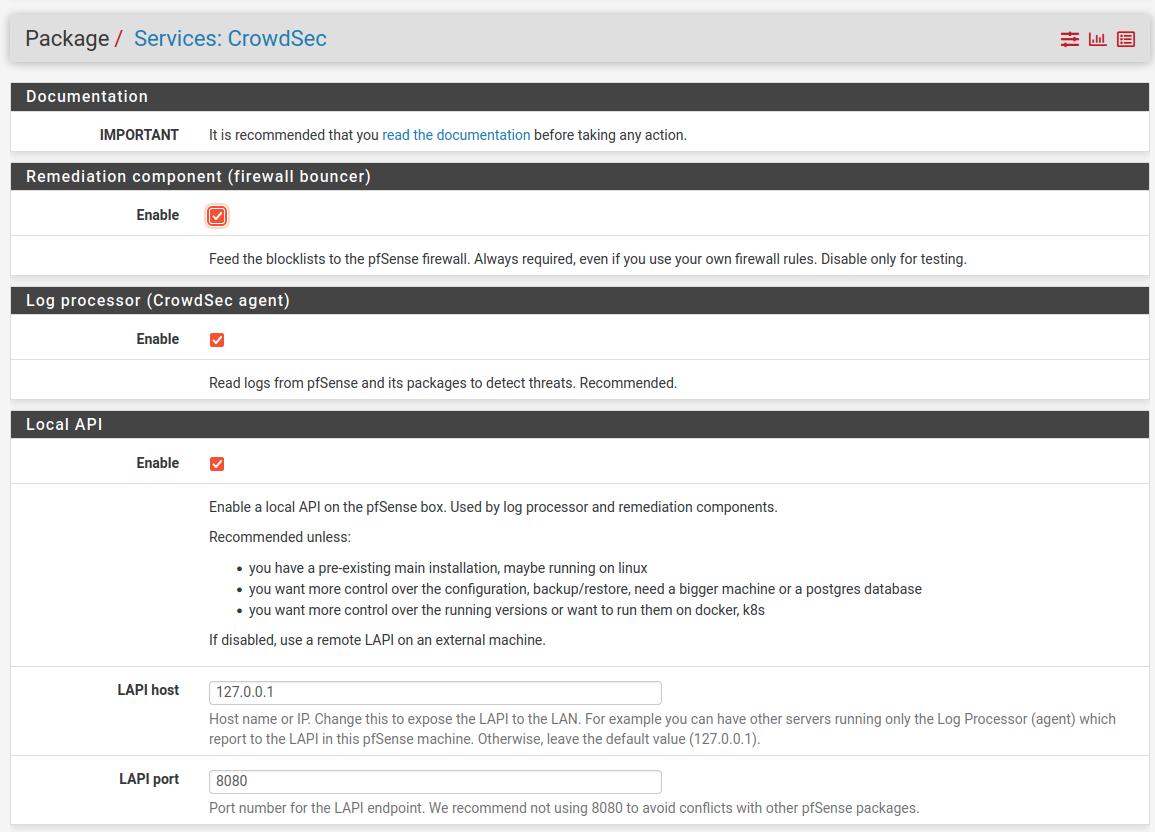
With the size analogy, the default is a "Large", autonomous installation.
For a "Medium", disable Local API and fill the fields in the Remote LAPI section.
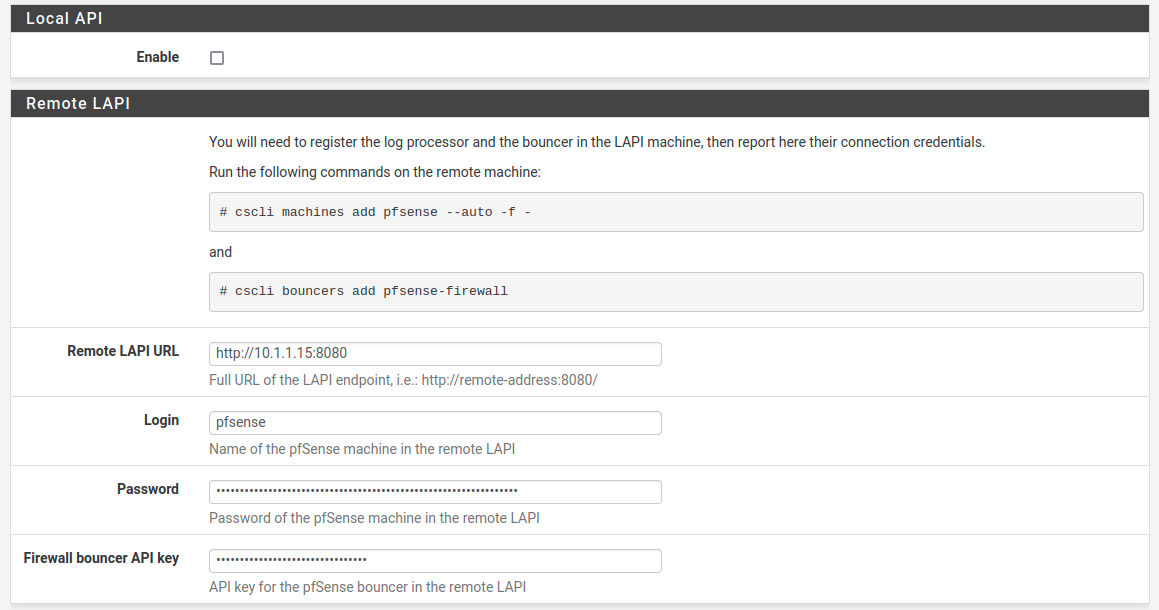
For a "Small", disable Log Processor too.
CrowdSec on pfSense is fully functional from the command line but the web interface is read-only, with the exception of decision revocation (unban).
Most other actions require the shell or the CrowdSec Console.
For simple things, Diagnostics/Command Prompt works as well as ssh.

You are free to edit the files in /usr/local/etc/crowdsec, although some setting may be overwritten by the pfSense package if they are mandatory.
Service Status
In the page Status/CrowdSec you can see
- registered log processors and remediation components
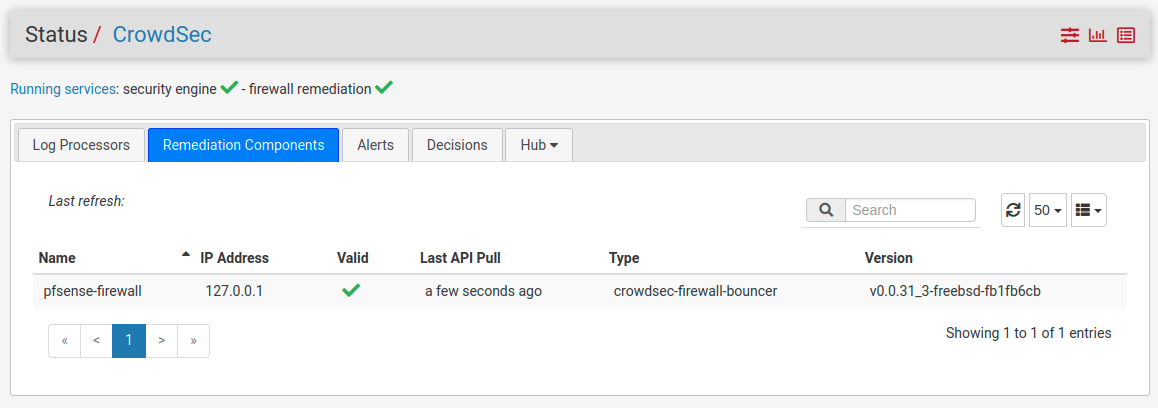
- installed hub items (collections, scenarios, parsers, postoverflows)
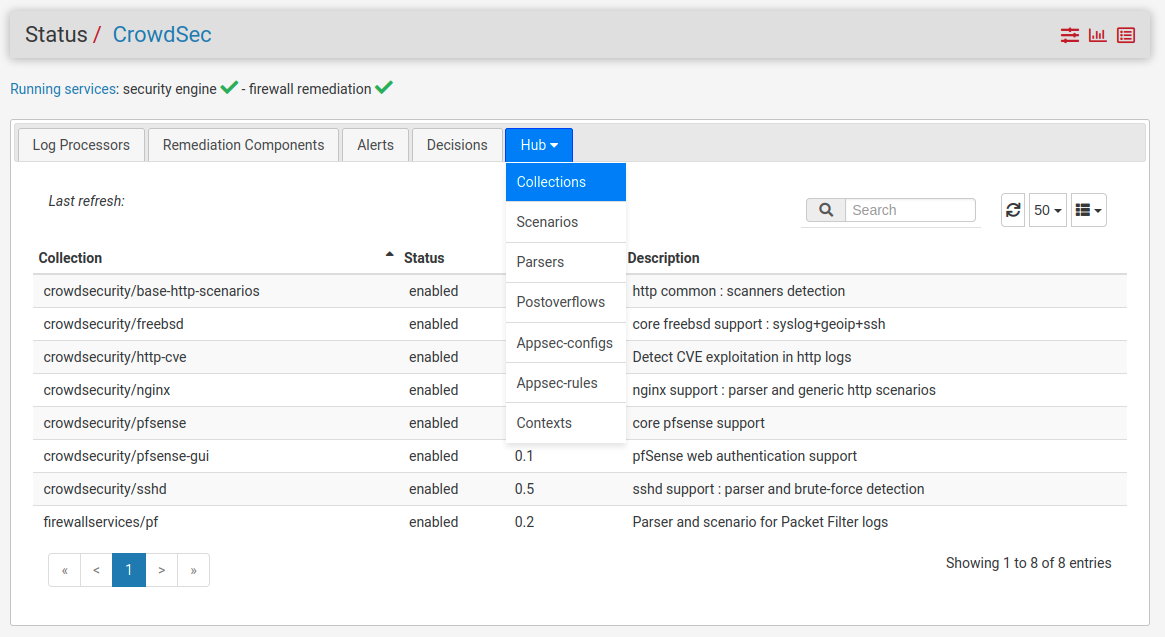
- alerts and local decisions

All tables are read-only with an exception: you can delete decisions one by one, to unban an IP for example. An IP may have been banned for several reasons, which counts as separate decisions.
All hub objects are periodically upgraded with a cron job.
Detecting attacks
If a Log Processor is running, the following scenarios are enabled by default:
- portscan
- ssh brute-force
- pfSense admin UI brute-force
- HTTP vulnerability probing
These will trigger a ban on the attacking IP (4 hours by default) and report it to the CrowdSec Central API (meaning timestamp, scenario, attacking IP, for inclusion in the Community Blocklist.
You can add scenarios to detect other types of attack on the pfSense server, or connect several log processors to the same LAPI node. Other types of remediation are possible (ex. captcha test for scraping attempts).
If disk space is not an issue, you can increase the maximum size of log files before they are compressed and rotated. This will help us in case you report acquisition issues and we need to match the application behavior with the content of the acquired logs.
We recommend you to register to the Console, especially if you protect several machines.
Processing logs
If a collection, parser or scenario can be applied to a software that you are running on pfSense,
you add it with cscli collections install ..., then you need to configure where CrowdSec will find the logs.
New acquisition files should go in /usr/local/etc/crowdsec/acquis.d/. See pfsense.yaml for an example.
The option poll_without_inotify: true is required if the log sources are symlinks.
Make sure to reload or restart CrowdSec when you add new data sources.
Diagnostics
Under Diagnostics/CrowdSec Metrics you can check if the logs are acquired and the
events are triggered correctly.
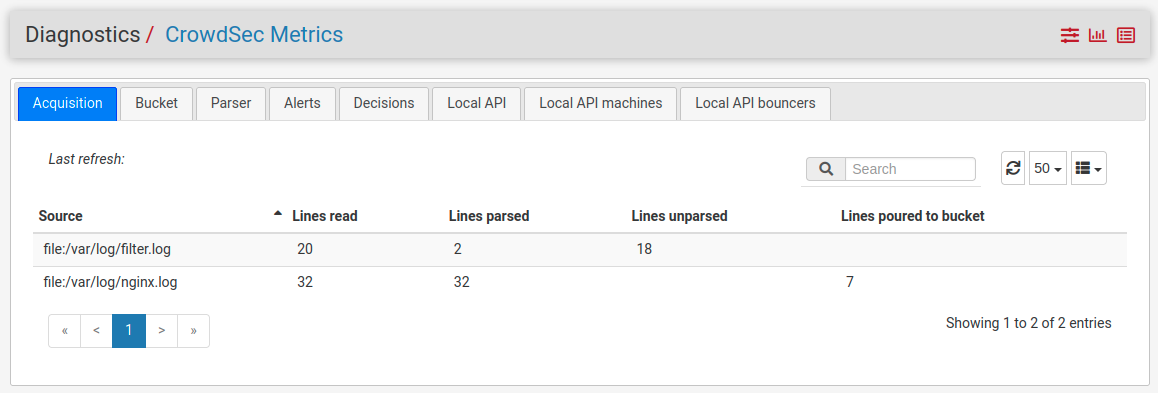

For real monitoring, you can fetch the same metrics with Prometheus (Grafana dashboard included) Telegraf or your favorite solution.
If you are not running a LAPI or a Log Processor, some metrics are always empty.
Logs
You can see the Security Engine logs in Status/System Logs/Packages/crowdsec.

Other logs not shown in the UI are in /var/log/crowdsec/crowdsec_api.log
and crowdsec-firewall-bouncer.log.
Service Management
Both services, Security Engine (crowdsec) and Remediation (crowdsec-firewall-bouncer) can be controlled from Status/Services.

The equivalent shell commands are service crowdsec.sh start/stop/restart and service crowdsec_firewall.sh start/stop/restart. Note the ending .sh!
Viewing blocked IPs
You can see the tables of the blocked IPs in Diagnostics/Tables
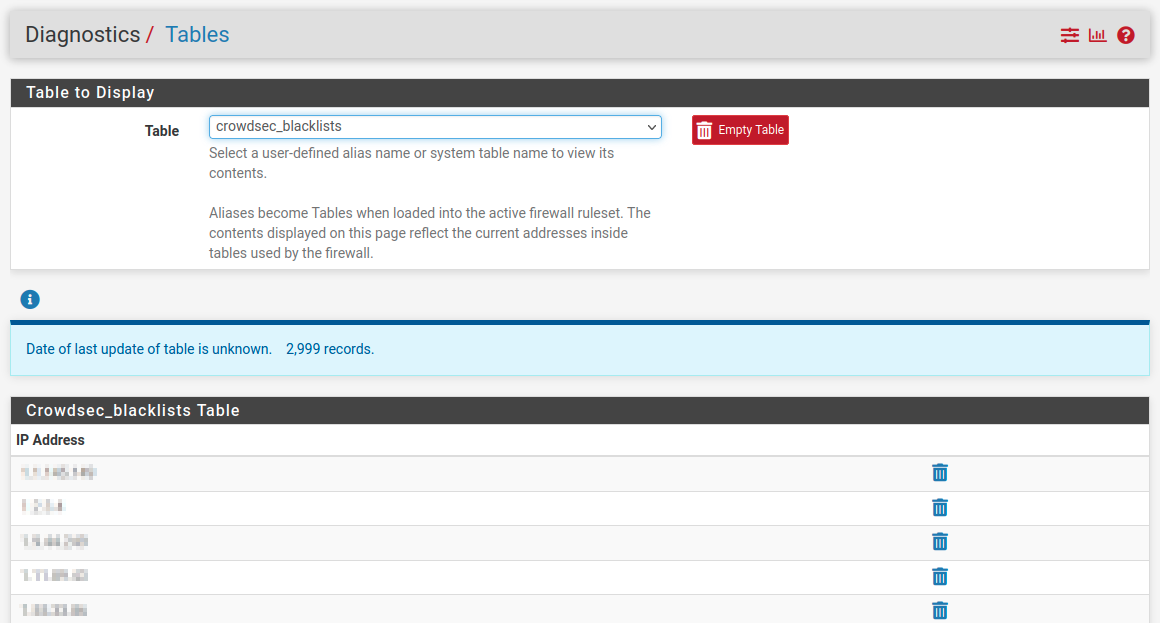
Or from the shell, with the commands
pfctl -T show -t crowdsec_blacklists (IPv4) and pfctl -T show -t crowdsec6_blacklists (IPv6).
To show the same data with more context, use cscli decisions list -a.
Testing
A quick way to test that everything is working correctly end-to-end is to execute the following command.
Your ssh session should freeze and you should be kicked out from the firewall. You will not be able to connect to it (from the same IP address) for two minutes.
It might be a good idea to have a secondary IP from which you can connect, should anything go wrong.
# cscli decisions add -t ban -d 2m -i <your_ip_address>
You may have to disable the Anti-lockout rule in
System/Advanced/Admin Access for the time of the test.
This is a more secure way to test than attempting to brute-force yourself: the default ban period is 4 hours, and CrowdSec reads the logs from the beginning, so it could ban you even if you failed ssh login 10 times in 30 seconds two hours before installing it.
It must be noted that the Login Protection service which is enabled by default on pfSense can be triggered - and block a brute force attacker - before CrowdSec does, because it's more sensitive. Still, some attacks that are not detected by Login Protection will be detected by CrowdSec and shared. If you need more CrowdSec tests you may want to temporarily disable Login Protection, depending on the scenario.
LAN / private networks whitelist
Since crowdsec 1.6.3, private IP networks are whitelisted by default as well. This means for example an IP from a LAN or WAN which is on 192.168.x.y won't get blocked by a local decision (community blocklists don't contain private IPs).
If you want to revert to the previous behavior, to block private IPs as well, you can remove the related parser.
[root@OPNsense ~]# cscli parsers remove crowdsecurity/whitelists
If on the other hand you upgrade from a version before 1.6.3, you need to install the lists yourself.
Uninstalling
In most cases, just remove the crowdsec package from
System/Package Manager/Installed Packages, or run the installation script with the --uninstall option.
This won't remove the database or configuration files, just in case
you want to reinstall CrowdSec later.
If you need to make sure you removed all traces of CrowdSec, you can run the following commands:
# pkg remove pfSense-pkg-crowdsec crowdsec crowdsec-firewall-bouncer
# rm -rf /usr/local/etc/crowdsec /usr/local/etc/rc.conf.d/crowdsec*
# rm -rf /var/db/crowdsec /var/log/crowdsec* /var/run/crowdsec*
For testing purposes, you may want to remove the <crowdsec> section
from /conf/config.xml as well.

